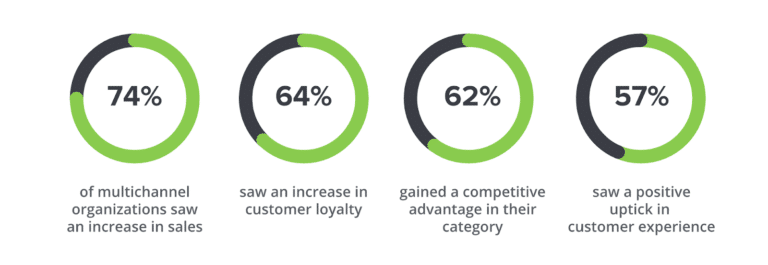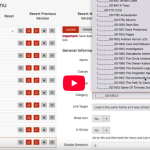
August 15,2023
The Benefits of Selling on Multiple Ecommerce Platforms
In today’s highly digital landscape, selling on multiple ecommerce stores can provide businesses with a significant advantage by offering better visibility and reach, allowing businesses to expand their audience and increase sales potential.
However, it is crucial to approach this strategy with careful planning and research. Starting small and gradually expanding across multiple platforms allows businesses to test the waters and evaluate which platforms align best with their audience. This ensures that resources are allocated effectively, to maximise the benefits of selling on multiple ecommerce platforms.
This article looks into the benefits of selling on multiple platforms, and highlights some tips for those wanting to start utilising multiple sales channels.
How selling on multiple platforms works
Selling on multiple platforms allows sellers to reach a wider audience and increases their sales potential. You can list your products on various online marketplaces like Amazon, eBay, and Etsy, as well as having an independent ecommerce store.
Each channel will require its own set of logistics, inventory management, and marketing strategies. Sellers will need to manage inventory, orders, and customer interactions across platforms. They should also ensure that pricing, product descriptions, and images are tailored to suit each platform’s requirements.
Expand your customer reach
As you might expect, if you are selling a product on multiple platforms, you are going to have access to a larger audience, increasing your overall online presence. There are countless platforms and marketplaces where you can showcase and sell your products, leveraging the existing audience of these marketplaces. This can help you to tap into different demographics and increase your customer reach.
One way you can expand your customer reach through selling on multiple platforms is by being specific on where you sell. For example, if you sell handmade jewellery, you might find more success selling on platforms like Etsy and your own website, rather than on Amazon. ‘To keep your customers satisfied, it’s important to know them.’ This way, you can reach different groups of people who prefer different shopping experiences, but all have a joint interest in your products.
Reduced dependency on a single platform
Relying solely on one platform might limit how much your business is able to sell. Selling across multiple channels is a great way of not only increasing your sales efforts, but will also help to mitigate risk. If you are selling on one platform, and this single platform experiences some technical issues, for this point let’s say the site goes down, your sales could suffer significantly.
Spreading yourself across more than one platform means your business won’t be as dependent on a single platform; therefore, you will be able to maintain business should something go wrong across another platform. This is one of the reasons why many sellers are opting for selling across more than one platform.
Competitive advantage
Selling your products across multiple channels gives your business a competitive advantage. By listing your products on other ecommerce stores, you will reach more customers on their desired platforms, you can meet customers where they prefer to shop. For example, some customers may prefer shopping somewhere like Amazon, while others may prefer social media platforms.
As demonstrated in the image below, multichannel selling leads to a 62% increase in competitive advantage. It also demonstrates the large increase in sales and experience.

https://capturly.com/blog/9-solid-tips-for-multi-channel-e-commerce-brands-to-succeed/
Build brand awareness and drive traffic to your main website
Building brand awareness is one of the most crucial parts for building any successful business. Having a presence on various reputable platforms bolsters your brand’s credibility. When customers encounter your products on multiple platforms, they perceive your business as established and trustworthy. This can instil confidence in potential buyers who may not be familiar with your brand.
Furthermore, selling on multiple channels exposes your brand to different customer demographics across various platforms. This increased visibility helps you can tap into new markets and capture the attention of potential customers who may not have discovered you otherwise.
This allows for better customer engagement and interaction, as customers can choose their preferred platform for purchasing and communicating with your brand. Ultimately, selling on multiple platforms can lead to increased sales and brand loyalty, as customers have more opportunities to engage with your brand and make purchases.
Increased sales opportunities
As we’ve established, selling on multiple platforms will increase your reach and visibility. If your business is more visible and reaches more clients, as a result your sales are going to increase. This is due to an increase in opportunity. One study found that ‘By diversifying your sales channels, you can leverage the strengths and unique features of each platform to attract different types of customers’. An example of this might be the customer reviews on Amazon that will increase trust and therefore sales.
One study found that Amazon and Ebay were the top two marketplaces for selling online. Amazon has 400 million visits per month, and eBay with 252.5 million per month in the UK alone. With this in mind, being able to sell to both of these audiences is absolutely essential for any business wanting to sell their products. The sheer size of these audiences alone is enough to tempt business to test the waters.
Tips for selling on multiple platforms
Start small
With the many opportunities presented with selling online it might be tempting to go ahead and put your products everywhere. However, it’s important that you start small as you don’t want to spread yourself too thin.
We recommend you pick one or two platforms to start off on, such as Amazon or Ebay. Once you’ve chosen your platform, select some of your inventory.
One study notes that,’You can start smaller by posting a part of your inventory on several different channels’ . It is not recommended that you put your entire inventory on these channels when you start out as it may cause issues with managing your stock.
So how should you manage your inventory?
Managing your inventory
When starting out, managing your inventory can be tricky. This is because there will be nooks and crannies that you will need to figure out. For example, if you spread 200 of your products equally acoss eBay and Amazon, you might find that your stock sells better on one platform over the other, and therefore in hindsight you might have been better to sell more on one platform than the other. This is all info that you will learn over time and that will help you to streamline your inventory process.
One thing you can do to manage this is to automate your inventory.
Automating inventory management when selling across multiple platforms streamlines operations, saves time, and can prevent errors. A central inventory management system is essential for this process. This eliminates the risk of overselling or running out of stock. Automated inventory tracking also enables accurate reporting, which can help you to make beneficial business decisions in the future.
Research the different platforms
Researching the different channels that you might sell on is very important. This is because it allows you to understand the different features, policies, and target audiences of each platform, helping you to make informed decisions about where is best to sell your products (whether that’s eBay, Amazon, Etsy, e.t.c.)
Investing time in research upfront can save you from potential issues, such as account suspensions or limitations, and help you maximise your reach and sales potential.
Bad customer service from a third party can reflect poorly on your brand.
Researching different platforms is also important because if you chose a ‘bad’ channel, this might reflect poorly on your brand. For example, bad customer service from a third party. It can lead to frustrated and dissatisfied customers who may associate their negative experience with your business. Poor customer service can also decrease customer satisfaction and trust, impacting future sales and potential business growth.
Additionally, if customers feel that your brand does not prioritise their needs, they may seek out your competitors instead. Ultimately, it is essential to ensure that third-party customer service providers align with your brand values to maintain a positive brand perception and customer experience.
Research competitors
As well as researching the channels you will be selling on you should also dedicate some research to your competitors.
We recommend you research the following:
Identify market trends and customer preferences
Determine competitive pricing strategies
Understand competitor’s marketing and promotional strategies
Learn from competitor’s mistakes and improve your own selling strategy
Identify potential threats and challenges
Gain insights into customer reviews and feedback
Once this is done you should have a greater understanding of how you can differentiate from your competitors, as well as, what’s going good and bad for them to adapt your strategy.
Final thoughts
Selling on multiple ecommerce platforms offers numerous benefits that can give your business a competitive advantage. By diversifying your sales channels, you reduce dependency on a single platform and mitigate the risk of any potential issues that could occur from selling on a single platform.
Furthermore, selling on multiple platforms increases your revenue potential by tapping into different customer bases and markets. With better visibility and a wider reach, you have the opportunity to expand your audience and increase sales.
However, it is important to do thorough research before venturing into multiple ecommerce platforms. Starting small allows you to test the waters and understand which platforms align best with your product or service offerings.
Selling on multiple ecommerce platforms can open up new opportunities for growth. You can attract a larger audience, and ultimately drive more sales.
So why limit yourself to just one platform when there are so many opportunities waiting for you?




